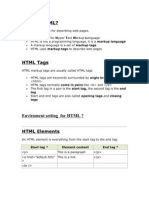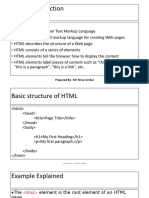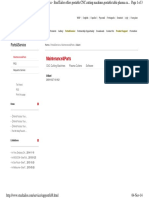HTML (Hyper Text Markup Language)
What is HTML?
HTML stands for Hyper Text Markup Language
HTML is the standard markup language for creating Web pages
HTML describes the structure of a Web page
HTML consists of a series of elements
HTML elements tell the browser how to display the content
HTML elements label pieces of content such as "this is a heading", "this
is a paragraph", "this is a link", etc.
HISTORY
�HTML STRUCTURE
�HTML TAG
TYPES OF TAGS
1. Paired Tags
2. Unpaired Tags
Paired Tags
Paired Tags are tags with both opening and closing. They can
have child tags, plain text and attributes. For
example <p>, <h1>, <body> etc.
Unpaired Tags
If any html tag has both opening and closing tag in a single tag,
then such html tag is known as unpaired tag.
Ex: br, hr, img, etc.
�HTML Attributes
All HTML elements can have attributes
Attributes provide additional information about elements
Attributes are always specified in the start tag
Attributes usually come in name/value pairs like: name="value"
Ex: <img src="img_girl.jpg" width="500" height="600">
Headings in HTML
Example:
<h1>Heading 1</h1>
<h2>Heading 2</h2>
<h3>Heading 3</h3>
<h4>Heading 4</h4>
<h5>Heading 5</h5>
<h6>Heading 6</h6>
�Output:
Paragraph and br tag
Example:
�Output:Example:
�Example for Formatting Elements
��Output:
Image Tag :
�Video Tag :
The HTML <video> element is used to show a video on a web page.
The controls attribute adds video controls, like play, pause, and volume.
It is a good idea to always include width and height attributes. If height and
width are not set, the page might flicker while the video loads.
The <source> element allows you to specify alternative video files which the
browser may choose from. The browser will use the first recognized format.
The text between the <video> and </video> tags will only be displayed in
browsers that do not support the <video> element.
Example :
<video width="320" height="240" controls>
<source src="movie.mp4" type="video/mp4">
<source src="movie.ogg" type="video/ogg">
Your browser does not support the video tag.
</video>
Outcome:
�Audio Tag:
The HTML <audio> element is used to play an audio file on a web page.
The controls attribute adds audio controls, like play, pause, and volume.
The <source> element allows you to specify alternative audio files which the
browser may choose from. The browser will use the first recognized format.
The text between the <audio> and </audio> tags will only be displayed in
browsers that do not support the <audio> element.
Example:
<audio controls autoplay>
<source src="horse.ogg" type="audio/ogg">
<source src="horse.mp3" type="audio/mpeg">
Your browser does not support the audio element.
</audio>
Output:
�Marquee Tag:
Anchor tag:
�Table Tag:




















































































